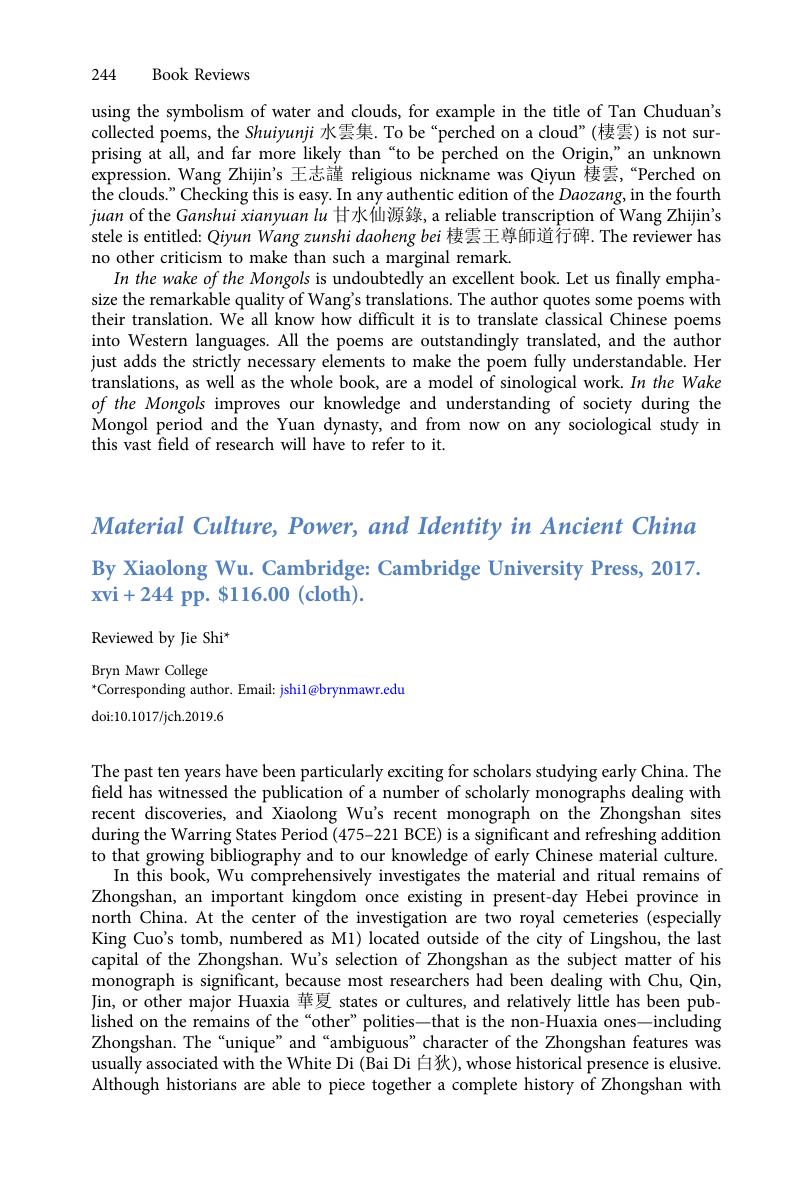No CrossRef data available.
Article contents
Material Culture, Power, and Identity in Ancient China By Xiaolong Wu. Cambridge: Cambridge University Press, 2017. xvi + 244 pp. $116.00 (cloth).
Review products
Published online by Cambridge University Press: 27 November 2019
Abstract

- Type
- Book Review
- Information
- Copyright
- Copyright © Cambridge University Press 2019
References
1 Lianqin, Duan 段連勤, Bei Di zu yu Zhongshanguo 北狄族與中山國 (Shijiazhuang: Hebei renmin, 1982)Google Scholar; Yanjie, He 何艶傑, et al. , Xianyu Zhongshanguo shi 鮮虞中山國史 (Beijing: Kexue, 2011)Google Scholar.
2 Hodder, Ian, Theory and Practice in Archaeology (London: Routledge, 1992)Google Scholar; Tilly, Christopher and Shanks, Michael, Re-constructing Archaeology: Theory and Practice (London: Routledge, 1993)Google Scholar.
3 Bunker, Emma, “Cultural Diversity in the Tarim Basin Vicinity and Its Impact on Ancient Chinese Culture,” in The Bronze Age and Early Iron Age Peoples of Eastern Central Asia, ed. Mair, Victor H., 2 vols (Washington DC: Institute for the Study of Man, 1998), 2: 611Google Scholar; Lin Yun 林沄, “Xiadai de Zhongguo beifangxi qingtongqi” 夏代的中國北方系青銅器, in Lin Yun xueshu lunwenji (er) 林沄學術論文集 (二) (Beijing: Kexue chubanshe, 2009), 7–19.
4 Shi, Jie, “The Hidden Level in Space and Time: The Vertical Shaft in the Royal Tombs of the Zhongshan Kingdom in Late Eastern Zhou (475–221 BCE) China,” Material Religion: The Journal of Objects, Art, and Belief, 11/1 (2015), 76–103CrossRefGoogle Scholar.
5 In fact, M1, M3, M6, and WPM2, in addition to PM1–6, were all cut partially into the bedrock; see yanjiusuo, Hebei sheng wenwu 河北省文物研究所, Zhanguo Zhongshanguo Lingshou cheng: 1975–1993 nian kaogu fajue baogao 戰國中山國靈壽城:1975–1993 年發掘報告 (Beijing: Wenwu, 2005), 215, 206Google Scholar; yanjiusuo, Hebei sheng wenwu, Cuo mu–Zhanguo Zhongshanguo guowang zhi mu ![]() 墓—戰國中山國國王之墓 (Beijing: Wenwu, 1996), 1: 445, 460, 472, 478, 486, 494Google Scholar.
墓—戰國中山國國王之墓 (Beijing: Wenwu, 1996), 1: 445, 460, 472, 478, 486, 494Google Scholar.
6 Dong Shan 董珊, “Zhanguo timing yu gongguan zhidu” 戰國題銘與工官制度 (PhD diss., Peking University, 2002), 118.




